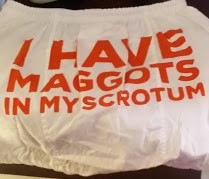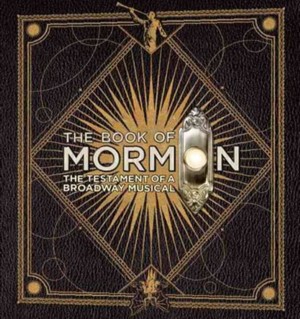Back in the mid 1960's when I was at university and still living at home with my parents in Thornleigh, two dark suited, white shirted, dark tied, earnest young men, fresh from the United States, appeared at our door.
Having discovered that they weren't from IBM my mother was all for shooing them away. But I was taking an interest in philosophy and psychology and here were two interesting examples of religious fervour.
As I often have with similar missionaries (see: Daniel, the Jehovah’s Witness in Easter on this Website), I invited them in and they were very pleased to tell me about their book. I remember them poised on the front of our couch, not daring or willing to sit back in comfort, as they eagerly told me about their revelation.
And so it came to pass that a week ago when we travelled to Melbourne to stay with my step-son Lachlan and his family and to see the musical: The Book of Mormon I was immediately taken back to 1964.
Back then the Mormons were famous for two things The Mormon Tabernacle Choir, that in 1963 had hit the charts with two gold albums: The Lord's Prayer and Handel's Messiah, and their increasingly controversial concerns about miscegenation, the cross-breeding of the races. This concern had famously led them to develop (and still maintain) the most complete genealogical record in the world: containing 2 billion names, organised into more than 35 million families and 'pedigrees'. This vast database remains protected behind 14-ton nuclear blast proof doors in the Granite Mountain Records Vault, a climate-controlled repository built into the Wasatch mountain range, about 20 miles southeast of Salt Lake City.
My only subsequent contact with Mormons was when my one time brother-in-law Nigel, Brenda's brother, fell in love with a girl from Salt Lake City who followed him to Newcastle (New South Wales) and somewhat inconveniently insisted that she needed a gun by her bedside for protection. Over dinner one night one of us asked about the miscegenation thing and the Mormon attitude to other races. She said that her brothers had once been members of the Klu Klux Klan but that we shouldn't be concerned about that. The Klan has attracted bad press she said. In Salt Lake City it's just like the Boy Scouts. The romance ended not long after - possibly due to the difficulty of getting a gun licence for unsecured firearms.
I have to confess that I've not kept up with Mormon theology so I thought that it was an amusing mockery of their racism when the young 'elders' in the Musical find themselves sent to seek converts in Uganda. But as we learn during the stage production, God changed his mind on this subject and in 1978, the 'First Presidency and the Twelve', received a new revelation from Him instructing them to reverse the 'racial restriction policy'. And so the The Church of Jesus Christ of Latter-day Saints now 'opposes racism in any form'.
But quite a bit has not changed. In 1964 the young men, not much older than I was at the time, left me with their book and promised to return a few days later. I read it with growing amazement. I mean, the good old King James is a bit hard to believe in places, what with animals two by two and so on, but this seemed to take credulity to a new level: lost tribes and even Jesus leaving the Levant for the Americas using no known means of transportation, even before the Vikings in their longships; visiting angels; and buried gold plates that only Joseph Smith had been given the means to translate - surprisingly into King James English. Tolkien had nothing on this, there were angels and miracles enough to satisfy even the most ravenous consumer of not very literary fantasy.
It was only a few years since I had rejected traditional religion myself so I foolishly tried to persuade the 'elders' that this was the most patent nonsense I'd ever read, only to be met with blank looks, as if it was me who was mad; and no doubt damned. When I tried an appeal to my own authorities like Bertrand Russell, at that time my favourite rational thinker, I was told that: whoever he is must be in league with the Devil, as it is the Devil who sews (sic - see comments below) doubt.
I kept their book for many years and would bring it out after dinner whenever the conversation had moved to the psychology of pathological belief in the totally irrational.
Among the theological questions raised by the musical, The Book of Mormon, is the problem of suffering. How can one continue to believe in a benign, all powerful God in the face of so many evils? "I have maggots in my scrotum," questions one of the benighted Ugandans - and he's the doctor. Perhaps God is not benign; or all powerful; or perhaps he doesn't exist at all?

As the Ugandan villagers chant and the young men join in until they discover its meaning: Hasa Diga Eebowai.
One of my respected friends has called it 'juvenile' but as a result of my 1964 experience I was smiling from the very first scene; then giggling; then laughing uproariously; then mopping my eyes. And the happy ending is also very clever. I loved this musical. I won't ruin it for you if you've not seen it but it goes to the imaginative origins of religion. As one of the youngest and best documented religions The Church of Jesus Christ of Latter-day Saints is a wonderful case history, surpassed only by Scientology, separately satirised by the writers, the team who brought us South Park.
And to top it all off, when I next watched Jeopardy!, from the good old USofA - perhaps the best quiz show in the world, you know, the one in which the answer is given and the contestants must provide the question, the subject of Final Jeopardy was 'Famous Americans'. The answer was: 'he had over 1,000 descendents by 1902, only 25 years after his death'. I immediately knew the appropriate question: 'Who was Brigham Young'. Yet none of the, otherwise very knowledgeable contestants, who seemed to know a lot about everything else, including trivial nonsense about US TV and baseball, did. They'd not been to see The Book of Mormon.
***
We'd used public transport to get to the Princess Theatre, from Williamstown, and as it was a Sunday we erred on the side of commuter caution, arriving almost an hour early. Time for a bit of Melbourne sightseeing. The Victorian Parliament was open to the public. We got in line but a person with a counting device arrived to tell us, and everybody behind us, that we would have to wait until the next tour, in half an hour.
Then we spied a spire: St Patrick's Roman Catholic Cathedral. That could be interesting. On the way we noticed that several other religious institutions were open to the public like the East Melbourne Synagogue and St Peter's Eastern Hill Anglican church. So we went on a church crawl.
The first stop was St Peter's and it wasn't wasted. To someone interested in the strange convolutions of religion it's a wonder. The handout to visiting members of the public states that: "St. Peter's is the oldest Anglican Church in Melbourne still standing on its original site. The foundation stone was laid by the Superintendent of the Port Phillip District, Charles La Trobe, on 18 June 1846... From its earliest days, St. Peter's has been distinguished as one of the main centres of Catholic revival within the Anglican Church. The parish has, so far, had only eleven incumbents over its 171-year history... The interior of the church, as it now stands, dates essentially from the 1920s. The main focus of St. Peter's is the High Altar with its splendid Italian mosaic, the set of six altar candlesticks and matching crucifix and two large standard candlesticks... The sanctuary light, kept alight at all times, denotes the presence of the Blessed Sacrament. The Iconostasis, a gift from the Icon School on the occasion of the 160th anniversary, adds to the visual impact on entry to the church."
Indeed the Iconostasis, more familiar in Eastern Rights churches, is extraordinary in an Anglican Church as are the 'stations of the cross' and Holy Communion celebrated not as 'The Eucharist' but as 'Mass'. One of the Icons is of St Mary Magdalene who is said to be 'at the Crucifixion'. Of course anyone who has been to St Peters in Rome knows this too. There she is in Michelangelo's Pieta with the fallen Jesus in her lap, looking younger than he does. Michelangelo had some fast talking to do.
We stayed briefly during the service but left strategically as the collection plate came around. I briefly asked the priest outside how this all went down with the Sydney Archdiocese. He looked to the sky and said 'not well' (or something of the sort) and then that they were 'very fond' of their form of worship. I was left wondering by his choice of words. Surely he knows that the Elizabethan Articles of Religion, establishing the English Church, use the expression 'a fond thing', usually followed by 'vainly invented' to mean something held in error by the Papists such as: transubstantiation; purgatory; or the adoration of saints.
From there we went to St Patrick's, somewhat less Catholic than St Peter's across the way since Vatican Two. That was another time when God changed His mind. Mass was in progress, with the faithful lining up for the transubstantiated body but no blood. As we sat in the northern transept a stretcher, wheeled by ambulance paramedics, rolled past with a well groomed man aboard, gazing upwards as if entranced; or dead. I wondered how a family could engage the ambulance to take a dying man to Mass but Wendy more rationally suggested that he had keeled over during the service and the Ambulance had subsequently been called. I hoped, for his sake, that as a good Catholic he had just been to confession. But then, perhaps that was the cause of his collapse?
Anyway, for a true believer a trouble-free way to go.
From there we narrowly avoided being run over by the ambulance, that was actually in no hurry, and headed for the Synagogue, Jesus' actual church, as we had observed during our visit to Nazareth. I thought I might need a Yarmulke (Kippah) to put on my head. I have a white one from Israel but it was in a draw in Sydney. It turned out that on Open Day it was unnecessary. Like the surrounding churches, the East Melbourne Synagogue is the oldest in Melbourne, continuously in use since 1877. As expected it was a nice, comforting space as are most religious places, mosques and ashrams included. The most unexpected feature in this place of worship, that is apparently frequented by Melbourne's Jewish legal fraternity, is a prominent mural, to the left of the Torah ark, setting out a prayer of allegiance to her majesty Queen Elizabeth in English and Hebrew. The ark was open to the public displaying the Torah Scrolls, the Old Testament law, in attractive blue fabric.
Later that day we would learn that the Book of Mormon is claimed to be the Third Testament. Although I think that that honour properly goes to the Koran.
So it further came to pass that it was a day of religious revelation.

